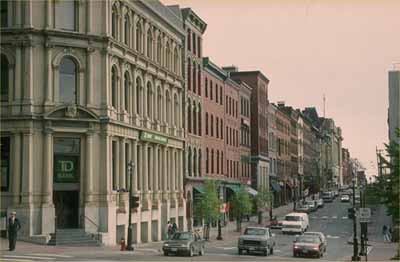Prince William Streetscape National Historic Site of Canada
Saint John, New Brunswick

Prince William Streetscape
(© Parks Canada Agency / Agence Parcs Canada, 1992.)
Address :
Prince William Street (Princess & Duke), Saint John, New Brunswick
Recognition Statute:
Historic Sites and Monuments Act (R.S.C., 1985, c. H-4)
Designation Date:
1981-06-15
Dates:
-
1877 to 1915
(Construction)
Other Name(s):
-
Prince William Streetscape
(Designation Name)
Research Report Number:
1981-OB-07, 2004-SDC/CDE-021
Plaque(s)
Existing plaque: Saint John, New Brunswick
This historic streetscape is distinguished by its rare concentration of homogenous, primarily late 19th-century architecture. Traditionally referred to as "Wall Street", the area contains major public buildings, banks, hotels, insurance, shipping and legal offices, and the Seamens's Institute and Mission. More than half of these structures were erected immediately after the Great Fire of 1877. The work of prominent architects of Scottish, American and Canadian origin, the buildings represent solid, dignified and sometimes flamboyant interpretations of contemporary styles and building technology.
Description of Historic Place
This streetscape comprises twelve public and commercial buildings in downtown Saint John, New Brunswick. These distinguished late 19th-century, masonry buildings are concentrated in a two-block stretch of Prince William Street in the vicinity of Princess and Duke streets.
Heritage Value
Prince William Streetscape was designated a national historic site in 1981 because:
this historic streetscape is distinguished by its rare concentration of homogeneous, primarily late 19th- century architecture; and the buildings represent solid, dignified and sometimes flamboyant interpretations of contemporary styles and building technology.
The heritage value of the Prince William Streetscape resides in the concentration of architecturally notable public and commercial buildings within a two-block area. Most were erected after the Great Fire of 1877, and their use of late 19th-century architectural styles, fire-retardant materials and fine craftsmanship illustrates the determination of the city of Saint John to rebuild its fortunes in the wake of the disastrous fire.
Source: Historic Sites and Monument Board of Canada, Minutes, June 1981.
Character-Defining Elements
Key features contributing to the heritage value of this site include:
urban plan with buildings abutting each other and built up to the sidewalk; consistent scale of three to four storeys; masonry construction materials, primarily brick and stone; use of high-style, late 19th-century architectural vocabulary, particularly Italianate and Beaux-Arts; elaborate detailing and craftsmanship.